Martial Eagle Profile
The Martial eagle is a large raptor from Africa. It’s not to be confused with the Marital eagle, which as everyone knows, hovers threateningly over the bed of newlyweds to make sure they consummate their marriage to God’s satisfaction.
Thankfully, the one of these that isn’t imaginary spends no time concerned with the copulation habits of humans. That’s a good thing, too, because the Martial eagle is one of the most formidable predatory birds there is.
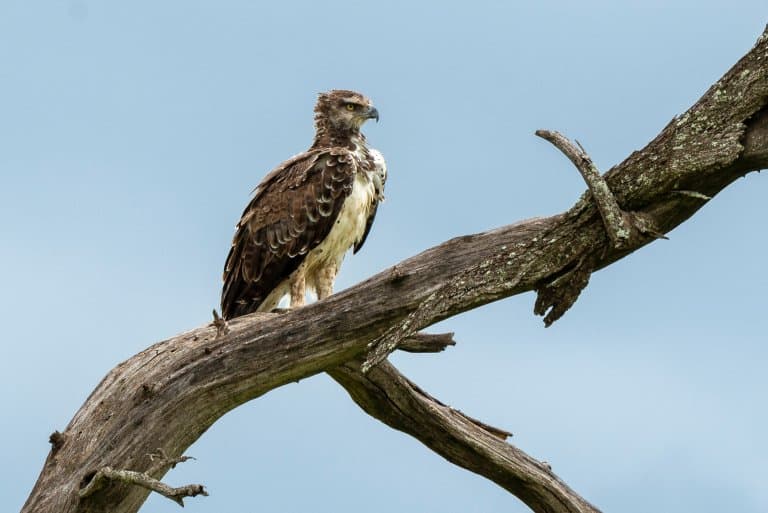
Martial Eagle Facts Overview
| Habitat: | Woods and bushes in Savanna, close to rivers |
| Location: | Sub-Saharan Africa |
| Lifespan: | Up to 25 years |
| Size: | Around 96cm (37 inches) long, 2.4m (7ft 10 inches) wingspan |
| Weight: | Males reach 6.2 kg (13.6 lb) |
| Colour: | Dark brown or grey with white belly |
| Diet: | Mammals, birds, reptiles, jackals, monitor lizards, wild cats, etc |
| Predators: | None |
| Top Speed: | Capable of a fast stoop |
| No. of Species: | 1 |
| Conservation Status: | Endangered (IUCN) |
Martial eagles are huge, powerful predators of the sky and land.
They inhabit open woodlands, bush areas and savanna in most of sub-Saharan Africa – with larger populations in South Africa and Zimbabwe.
These are animals that don’t shy away from a fair fight; they’ll take on almost anything that moves, and the meaner, the better. They have been nicknamed ‘the leopard’ of the air, and will diet on over 170 different species of mammals, reptiles and birds.
Sadly, their territorial nature and low-density populations, as well as their slow reproductive rate, have made them vulnerable to population decline and they’re now considered endangered.
Interesting Martial Eagle Facts
1. They’re the largest eagles in Africa
This is probably their main selling point, but it’s far from all they’ve got.
Martial eagles are beasts of the bird world, often reaching weights in excess of 6kg, and are contenders for the world’s heaviest eagle, perhaps only slightly behind the Stellar’s Sea Eagle, the Harpy Eagle and the Philippine Eagle.
They’re also one of the biggest, with a wingspan of well over 2 meters long, and this makes them magnificent monsters that can handle some impressive feats.
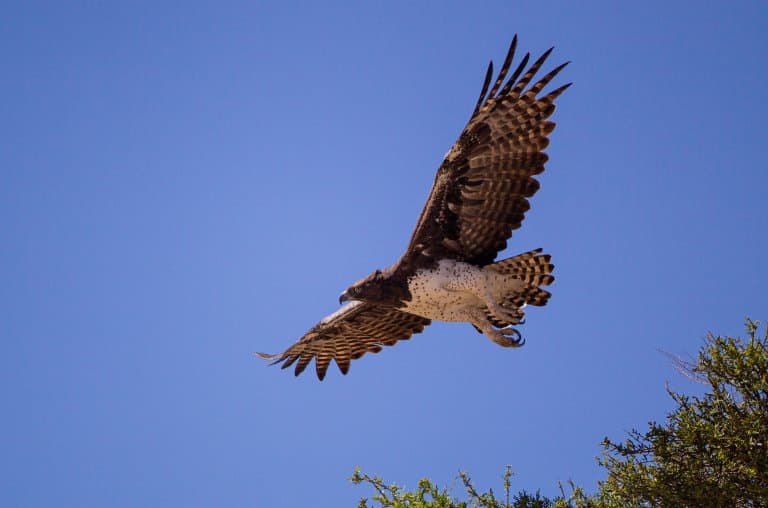
2. They are mostly silent
These are the kind of birds who don’t really want to be heard. They’ll barely make a peep outside of mating season and prefer to come across as silent and brooding.
They interact with their environment in relative silence, using instead their terrifying presence and amazing ability to spot prey to navigate their range.
3. They can spot prey at a distance of 5-6km (3-4 miles) away
Raptors do tend to have good eyes, but the Martial eagle has been estimated to have at least three to four times the visual acuity of humans.
This enhanced sharpness allows them to spot prey from dizzying heights and distances, sometimes are great as 6km away.
It’s thought this is some of the most impressive eyesight in the raptor kingdom, at least among those who hunt in the daytime. Their eyes are around the same size as a human eye, despite being much smaller animals. 1
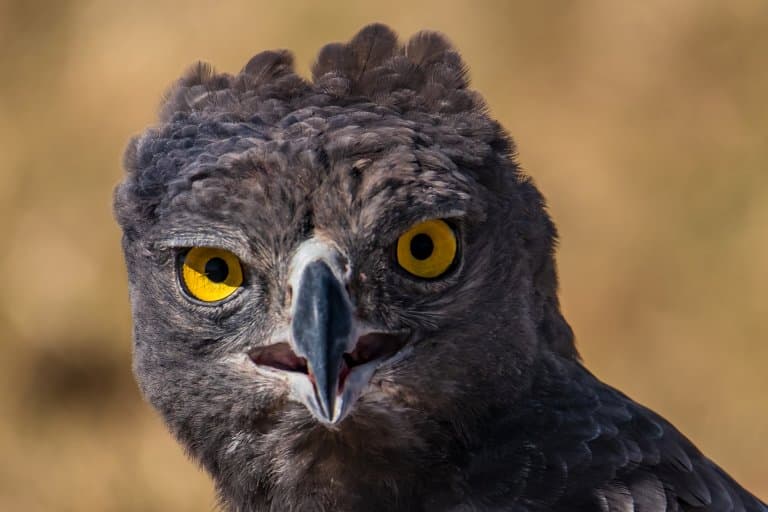
4. They’re powerful hunters
Lots of predators go for animals much smaller than they are, but the Martial eagle isn’t afraid to punch up.
It seems like they’re not fussy about where their prey comes from, as long as it’s large and puts up a good fight.
Common preferences for dinner include the world’s largest hornbill – a 4kg bird – and plenty of large, fearsome adult Nile monitor lizards.
They’re also fond of rock hyraxes, and in at least a couple of cases, an Aardwolf, a grey duiker antelope, and some mongooses. Sometimes, they’ll even tackle the world’s heaviest flying bird, the Kori Bustard.
A researcher in Kenya even discovered the remains of six Spotted Eagle Owls beneath a Martial Eagle’s nest. 2
5. They are one of the few eagle species to hunt from a high soar
Most of the prey a Martial eagle takes down is in the 1-5kg range. And considering the bird itself sits just above 6kg in the largest examples, this is rather impressive.
These eagles typically hunt using a shallow stoop, which involves spotting prey from a distance and coming in fast. They use their sharp hind toe claw which can measure up to 2 inches to kill their prey.
A lot of these kills are too large to be lifted back into a tree, so they’re partially consumed on the ground or torn in half and semi-abandoned.
On some occasions, a meal will be repetitively returned to over the course of several days to finish it off. This is likely not very common in areas where there are lots of scavengers around.
6. Martial eagle’s are apex predators
The martial eagle is at the very top the avian food chain in its environment, without any natural predators of its own. They’d sit nicely into our top 10 apex predators list.
Over a range of 60m2, Martial eagles would kill almost 300 animals a year to be satisfied.
This amounts to around 280kg of biomass removed from the territory of a single breeding pair and their clan, making them significant apex predators.
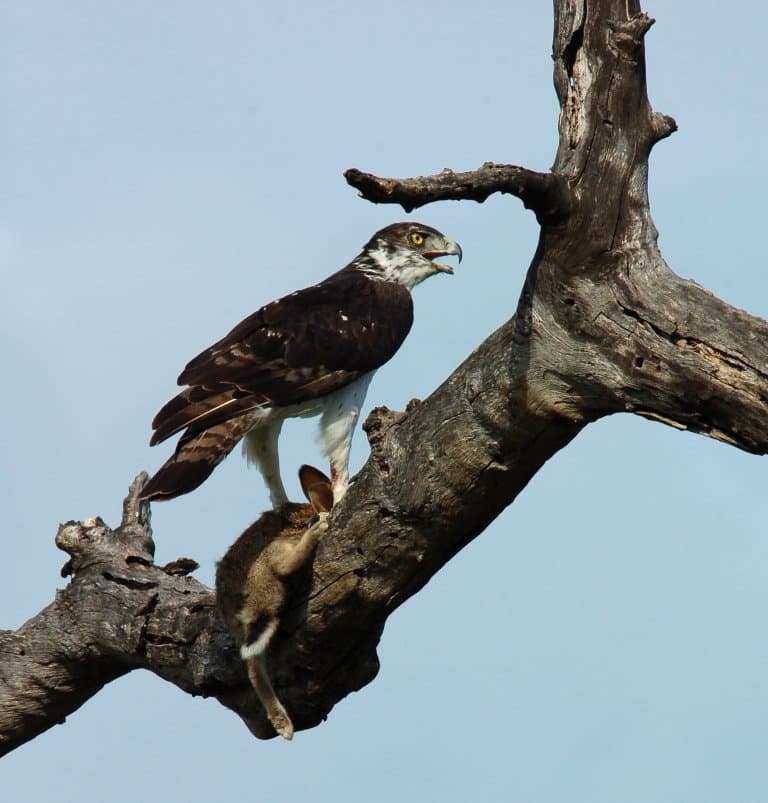
7. Females are larger than males
This is common for birds of prey, and holds true with Martial eagles which are highly sexually dimorphic.
Females are on average are 10% larger than males in height, and 36% in weight. Females are far bulkier, and have larger sturdier feet and legs.
8. They are wandering nomads
And these ranges can be enormous. These are low-density apex predators with high levels of territoriality, meaning that they don’t like one another to get too close.
But they don’t all feel this way. While many eagles are territorial, some are wandering souls and chose to float around over vast distances.
The average range for territorial eagles in Kruger National Park in South Africa is around 108 km2, but there are wandering nomads known as ‘floaters’ who spend their time going wherever they want across ranges as vast as 44,000 km2.
Sometimes, these floaters attract groupies, who may leave their established territories altogether and join the nomads.
It’s not entirely certain why they do this, but they may be responding to human encroachment and environmental degradation. The world of a floater is more dangerous and results in a higher level of mortality, and this is concerning for a species in decline. 3
9. They are one of the most persecuted birds
Across all its African range, this species is in trouble. It’s lost well over 60% of its population already, and the trend isn’t looking good.
Two emerging factors are thought to be predominantly responsible: the increase in temperatures from climate change, and the increase in power lines being erected.
In areas where both or either of these factors is at their highest, Martial eagle decline has been most significant.
But they’re also killed on purpose, for pet trades, traditional medicine, and fetish markets. Habitat loss is a significant factor for a bird that needs so much space, and this is compounded by the decrease in other animal species as a result of human encroachment, reducing the availability of prey items.
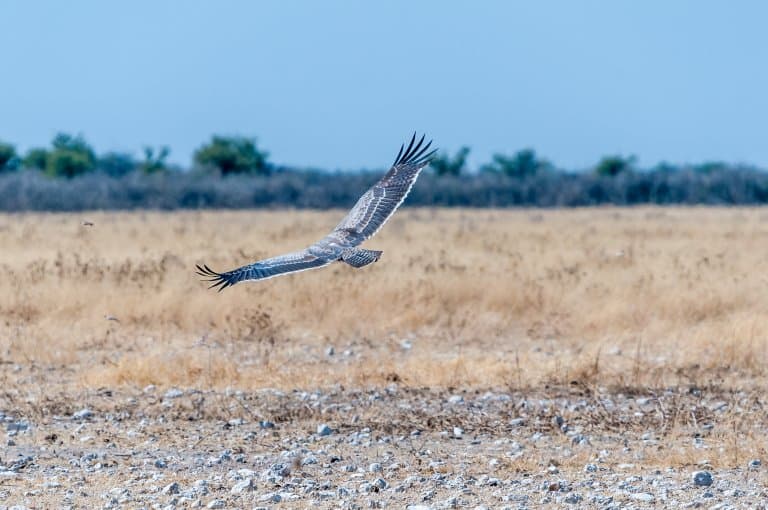
10. They have a slow breeding rate
As if all this wasn’t bad enough, these magnificent birds breed really slowly. That’s a problem for conservation since they are particularly vulnerable to population reduction and recover slowly when given the chance.
Martial eagles may lay a single egg as seldom as every two years, meaning that if adult populations decline, it’s a long, hard road to recovery for the remaining eagles. 4
Martial Eagle Fact-File Summary
Scientific Classification
| Kingdom: | Animalia |
| Phylum: | Chordata |
| Class: | Aves |
| Order: | Accipitriformes |
| Family: | Accipitridae |
| Genus: | Polemaetus |
| Species: | Polemaetus Bellicosus |
Fact Sources & References
- Rebecca L. Grambo (1999), “Eagles”, Voyageur Press, Inc.
- W.R.Tarboton, “The Status and Conservation of Birds of Prey”, Transvaal Museum.
- Rowen van Eeden (2017), “Ranging behaviour and habitat preferences of the Martial Eagle: Implications for the conservation of a declining apex predator”, Plos One.
- Daniël Cloete (2013), “Investigating the decline of the Martial Eagle (Polemaetus bellicosus) in South Africa”, University of Cape Town, Rondebosch.
